
Do you have a question about the Carrier 48TC*D and is the answer not in the manual?
| Model Number | 48TC*D |
|---|---|
| Refrigerant | R-410A |
| Type | Air Conditioner |
| Voltage | 208/230V or 460V |
| Sound Level | Varies by model, typically 70-80 dBA |
| Dimensions (L x W x H) | Varies by model |
| Weight | Varies by model |
Key tasks for quarterly checks and initial setup.
Tasks to be performed at the beginning of each season.
Instructions for accessing and replacing disposable fiberglass return air filters.
Description of the belt-drive system for the supply fan.
Guidance on checking belt condition and tension quarterly.
Description of the NOVATION Heat Exchanger Technology condenser coil.
Description of the traditional round-tube, plate-fin evaporator coil.
General recommendations for coil maintenance and cleaning.
How to determine and adjust the refrigerant charge amount.
Using cooling charging charts to adjust refrigerant for superheat.
How to determine and correct compressor rotation direction.
Steps for adjusting the condenser fan height for D08-D12 models.
Steps for adjusting the condenser fan height for D14 models.
Overview of the smoke detector system components and function.
Description of the smoke detector controller and its LEDs.
Description of the smoke detector sensor and its components.
Details on the location and installation of smoke detector sensors.
Procedure to test the sensor's ability to signal an alarm state.
Procedure to test the controller's ability to initiate an alarm state.
Steps to diagnose when the controller's Trouble LED is on.
Steps to diagnose when the controller's Trouble LED is flashing.
Steps to diagnose when the controller's Power LED is off.
Overview of compressor protection mechanisms.
Details on the high pressure switch operation and settings.
Details on the low pressure switch operation and settings.
General description of the gas heat exchanger system.
Information on natural gas and propane fuel types and pressures.
Inspection of main burners for deterioration or blockage.
Procedures for cleaning and adjusting burners.
Common causes and remedies for burner ignition failure.
Causes and remedies for inadequate heating performance.
Causes and remedies for burners not shutting off.
Information on repairing leaks in NOVATION condenser coil tubes.
Procedure for replacing the NOVATION condenser coil.
Overview of EconoMi$er IV control modes.
How outdoor dry bulb temperature controls the economizer.
Information about the OAT sensor and its characteristics.
Steps for wiring the indoor air quality sensor.
Using outdoor air enthalpy control with EconoMi$er2.
Using differential enthalpy control for economizer operation.
Mounting and wiring the return air enthalpy sensor.
Steps for wiring the outdoor air CO2 sensor.
How to connect the PremierLink filter switch input.
Configuration for the supply fan status input.
Connecting the PremierLink remote occupied switch.
Explanation of communication protocols used by control devices.
Information about the RTU-MP space temperature sensor.
Description of the SAT sensor used with RTU-MP.
Description of the OAT sensor used with RTU-MP.
Instructions for connecting the T-59 space sensor.
Explanation of communication protocols used by control devices.
Description of the BACview handheld interface.
Description of the Virtual BACview software.
Explanation of communication LED indicators.
Explanation of the Safety Chain Alarm.
Explanation of the Fire Shutdown Alarm.
Explanation of the Space Temp Sensor Failure alarm.
Explanation of the SAT Sensor Alarm.
Troubleshooting third-party communication and networking.
How economizer dampers are used for cooling and IAQ.
Information about the OAT sensor and its temperature range.
How outdoor dry bulb temperature controls the economizer.
Testing procedure for differential enthalpy control.
Testing procedure for single enthalpy control.
Testing DCV and Power Exhaust functions.
General steps for preparing the unit for initial start-up.
Ensure unit is installed per instructions and codes.
Check gas piping for leaks before start-up.
Performing system check-out before operation.
Procedures for initial unit operation and testing.
Using the Field Service Test function for proper start-up.
Configuration submenus related to the unit.
Configuration settings related to cooling operation.
Setting the number of mechanical cooling stages.
Setting the maximum supply air temperature for heating.
Defining the maximum outdoor air temperature for heating.
Configuration options for Input 3.
Configuration options for Input 5.
Configuration options for Input 8.
Configuration options for Input 9.
Selecting the type of space sensor installed.
Setting the minimum economizer damper position.
Setting the high outdoor air temperature lockout for economizer.
Setting the power exhaust fan activation point.
Indoor Air Quality control parameters.
Description and function of the Compressor Lockout Relay.
Function of the Phase Monitor Relay for power protection.
Configuring PremierLink for Thermostat Mode operation.
Conditions for indoor fan operation with PremierLink.
How PremierLink controls cooling operation.
How scheduling is used to start heating or cooling.
Setting the unit to run continuously.
Operating according to a configured local schedule.
Checklist items to verify before unit start-up.
Sections for recording electrical, temperature, and pressure data.
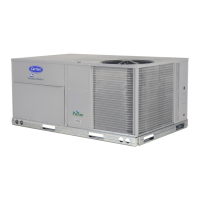
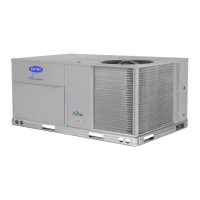
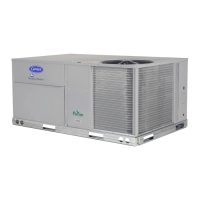

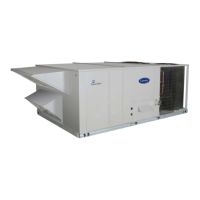



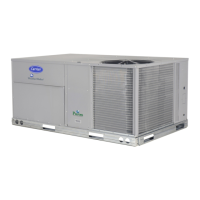


